
Transit Briefs: LACMTA, MDOT, Metrolinx, SEPTA, Trillium Line, TriMet
Written by Marybeth Luczak, Executive Editor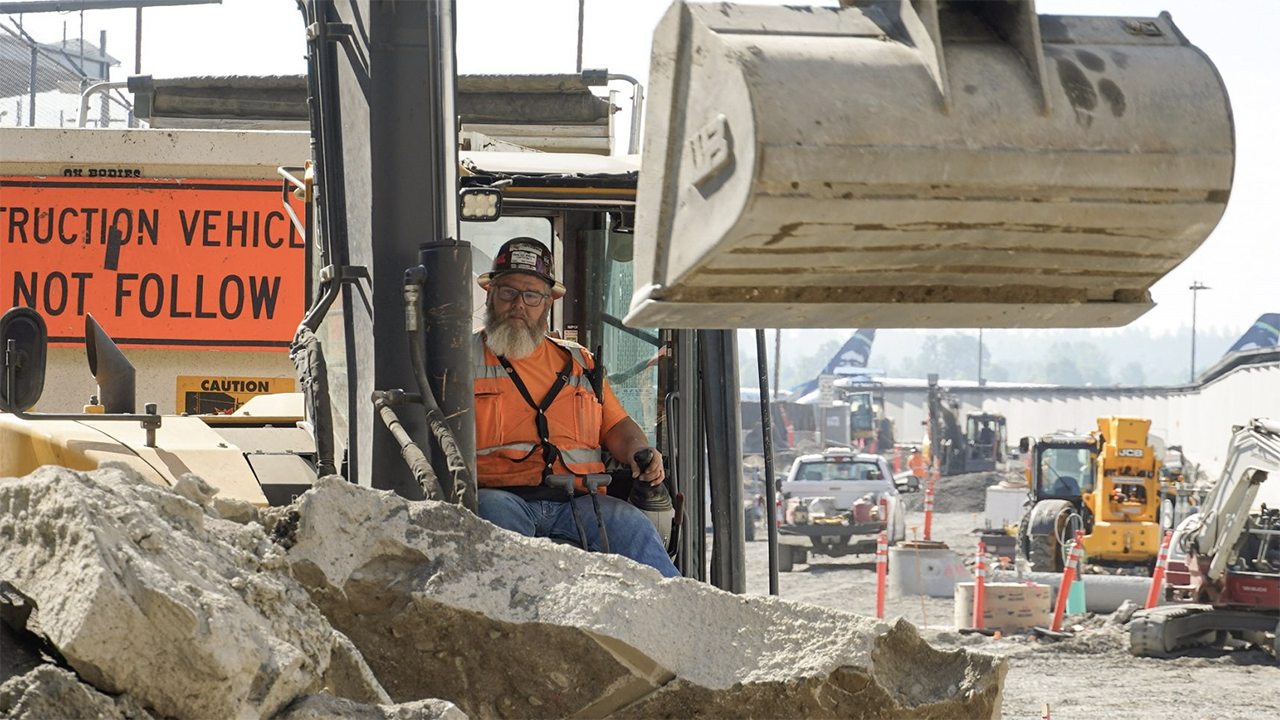
TriMet’s “A Better Red” project to completely replace the Portland International Airport MAX station and install a second track along the alignment, between the new station and Air Cargo Road, has hit its halfway mark. (TriMet Photograph)
A recent poll finds community support for Los Angeles County Metropolitan Transportation Authority’s (LACMTA) C Line (Green) extension to Torrance, Calif. Also, Maryland Department of Transportation (MDOT) and Maryland Economic Development Corporation (MEDCO) team on a new approach to transit-oriented development; the Ontario, Canada, government is investing in infrastructure upgrades at Metrolinx’s Aurora GO Station; six of Southeastern Pennsylvania Transportation Authority’s (SEPTA) 1940s-era PCC cars will return to service next month; the DMU Trillium Line’s hand-over to the city of Ottawa, Ontario, has been delayed again; and Tri-County Metropolitan Transportation District of Oregon (TriMet) is on schedule to reopen the MAX Red Line on Oct. 22.
LACMTA
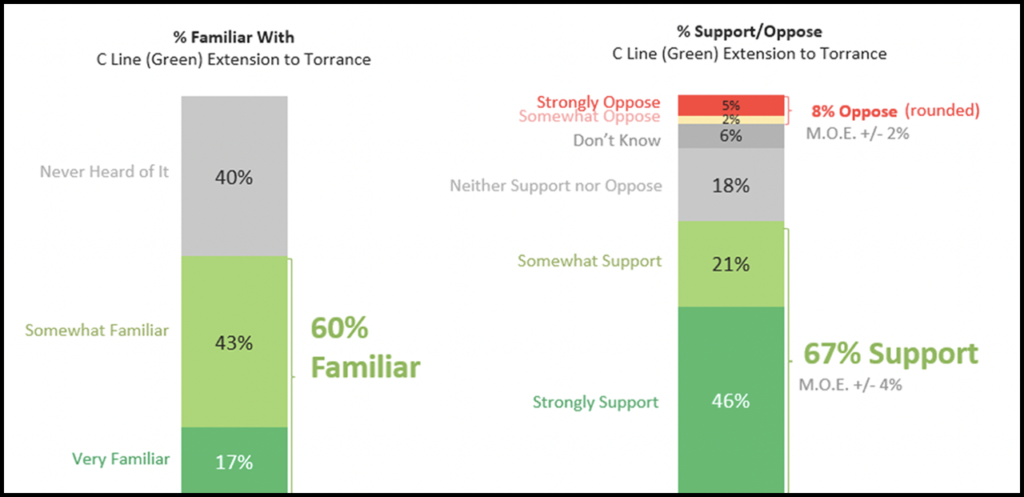
A recent poll shows support for the C Line (Green) Extension to Torrance Project from residents in Lawndale, Redondo Beach and Torrance, Calif., LACMTA reported Aug. 16. A market research firm surveyed 670 residents through randomized phone calls across the three project cities and found that 60% of residents are familiar with the project and 67% are supportive of it. On average, 8% of residents across the three cities oppose the project and 24% had no opinion of it, according to the transit authority.
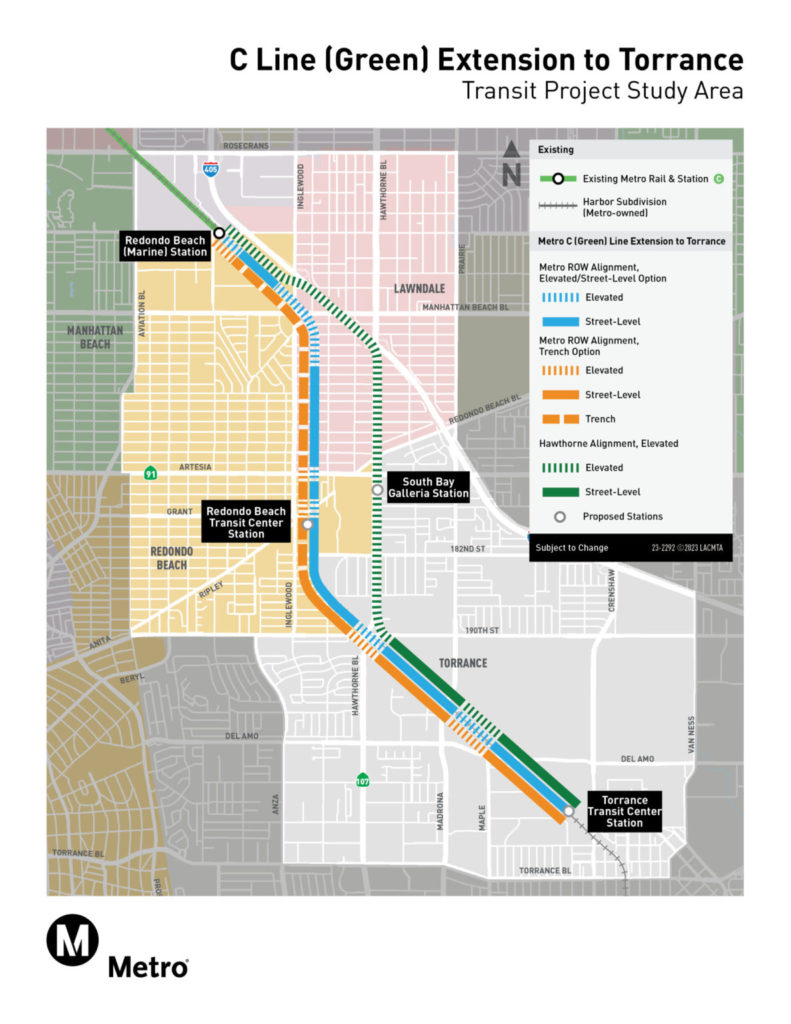
LACMTA plans to expand the C Line from the Redondo Beach (Marine) Station to the new Torrance Transit Center, bringing light rail to the area (see map, left); providing an alternative to congestion along the I-405 corridor; and connecting to the existing K (Crenshaw), J (Silver) and A (Blue) lines.
LACMTA said the following are among the project benefits:
• “The South Bay is a significant jobs center, and like many parts of LA County, suffers from congestion, a constrained housing supply, and limited convenient transportation options.
• “By providing a fast and reliable rail extension to the South Bay, the project will provide a convenient alternative to driving, that will attract between 11,500 to 15,600 trips per day by 2042; connect to two new bus transit centers in Redondo Beach and Torrance, which both recently opened this spring; help meet climate change goals by reducing vehicle trips, saving 49,000 vehicle miles traveled (VMT) per day and reducing air pollution and greenhouse gas emissions (GHGs) with a net reduction of 2,369 metric tons of carbon dioxide equivalent (MTCO2e) per year in 2042; and provide significant travel time savings for people accessing jobs, schools, and major events along the C, K and E lines.”
The LACMTA Board recently approved a new operating plan that will make the light rail extension to Torrance part of the Metro K Line. “This change means that travelers will have a one-seat ride (no transfers) from the South Bay to LAX, Inglewood, and the Metro E (Expo) Line—with easy connections to the Westside and Downtown Los Angeles,” the transit authority reported.
According to LACMTA, data from the Southern California Association of Governments (SCAG) anticipates the existing jobs/housing imbalance to worsen in the coming decades with employment growing twice as fast as the population in the South Bay. Connecting the South Bay to the regional rail network is critical to meeting future travel demand, expanding mobility options, and increasing access to opportunities for transit dependent riders, LACMTA reported.
As shown in the map below, LACMTA said that its modeling illustrates the project benefits, which extend along the K and C Lines between central Los Angeles, Gateway Cities, and as far south as the Palos Verdes Peninsula.
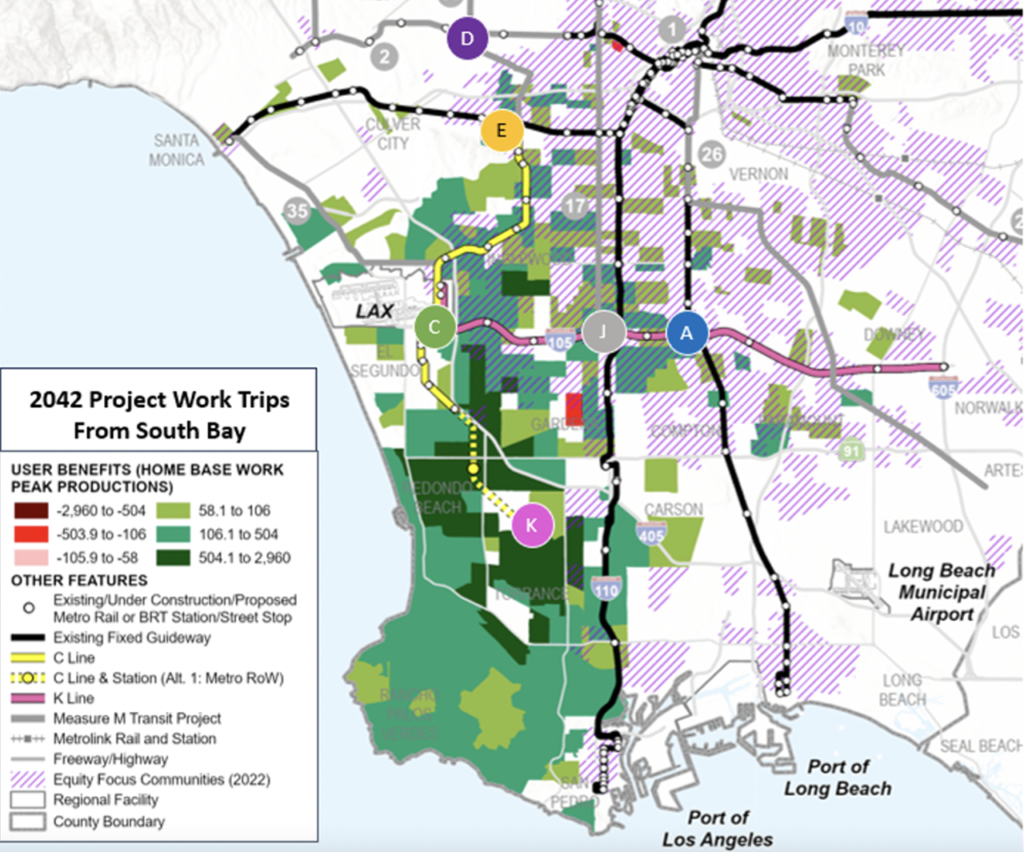
The transit authority on Jan. 27 released a Draft Environmental Impact Report (EIR) for public review, evaluating three alignments. It collected public comments over a 61-day review period, including five public hearings. Nearly 2,200 comments were received during the review period, with the majority—more than 1,800 comments—focused on alignment preferences, according to LACMTA. More than two-thirds of the alignment comments were in support of the transit authority’s elevated at-grade alignment. Only 6% were in opposition to the project.
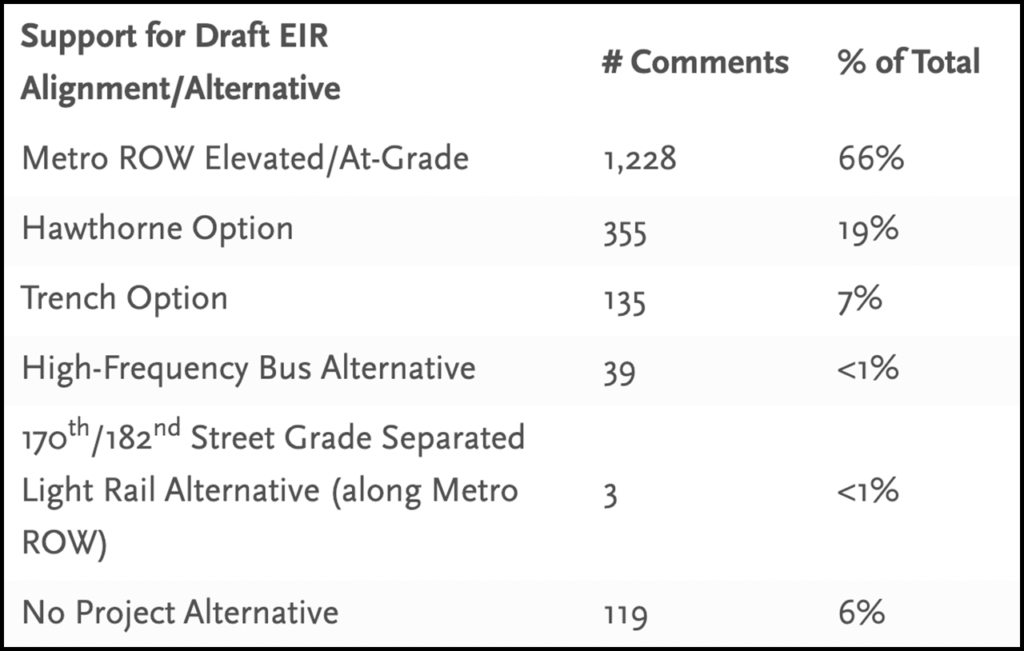
LAMTA said it is reviewing public comments. It is slated to provide a project presentation to a Board committee next month and will return to the Board with a staff recommendation for a Locally Preferred Alternative in October.
MDOT
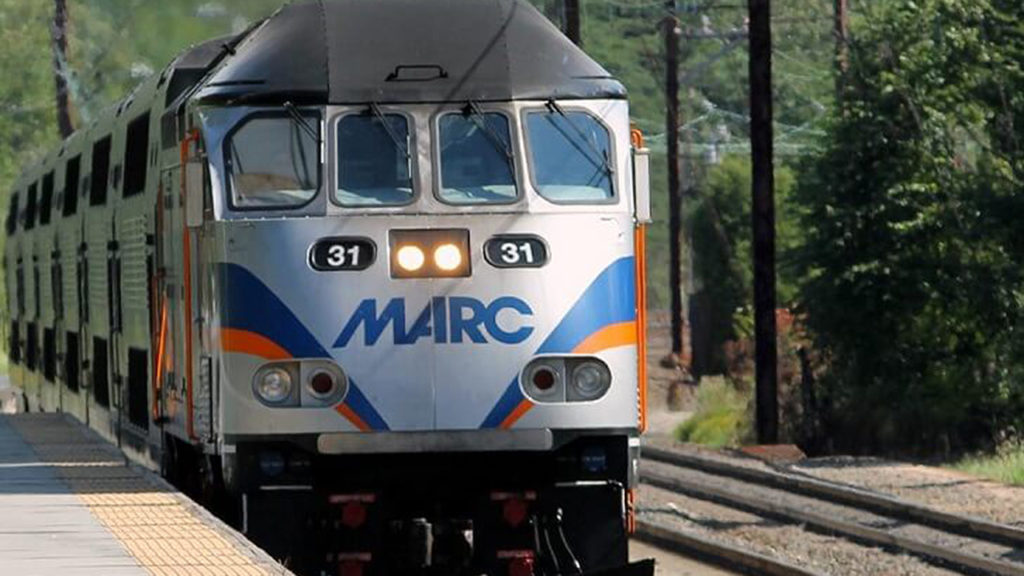
MDOT and MEDCO are teaming to launch transit-oriented development studies along the MARC Penn Line and around light rail and subway stations in the Baltimore region, the departments reported Aug. 16. In the past, Requests for Proposals (RFP) for joint development were issued based on immediate market needs. MDOT said it will now take a “proactive leadership role” before development partners are solicited. This approach, it pointed out, will enable the state to develop a strategy based on the type of transit service, partnerships with local jurisdictions, and the public investment needed to make transit-oriented development in Maryland as “impactful” as possible.
According to MDOT, the goal is to help shape a long-term vision for transit station sites as “community focal points” that support local economic development goals as well as housing and job creation; grow transit ridership by increasing mobility options and improving connections; increase revenue; and advance the state’s climate change goals.
Residents, businesses, community institutions, government agencies and others are slated to collaborate and determine “the right mix” of transit, retail, office, jobs, housing, essential services, walking and biking features and recreational space at specific sites, MDOT said, and then all stakeholders and government will work to implement it.
According to MDOT, the first steps are under way. MDOT and MEDCO have announced two RFPs, calling on the development and planning community to study new development at stations along the MARC Penn Line in the Baltimore-Washington corridor and to look for new ideas to support investment around light rail and subway stations in the Baltimore region. Responses are due before the end of the summer.
The MARC Penn Line RFP will launch a study of station sites, examining factors such as market potential, infrastructure, investment needs, benefits and financing. The study’s first phase, MDOT said, will look at the Seabrook, Bowie State, Odenton, Baltimore-Washington International Thurgood Marshall Airport, Halethorpe, and West Baltimore stations. According to the department, Penn Line stations are the busiest in the MARC commuter rail system, representing “great potential to create focal points for community growth and activity.” While there are about 50 acres of state-owned land adjacent to MARC stations along this line, the study is also expected to consider the idea that some publicly owned lands might join development or redevelopment plans.
A second phase of the Penn Line study will engage a similar review of MARC stations north of Baltimore, including Martin State Airport, Edgewood, Aberdeen, and Perryville. Both phases will take into consideration increased MARC service, said MDOT, which noted that cross-state service into Delaware and Virginia is anticipated based on Maryland’s recent framework agreements with both states to advance discussions and explore pilot service opportunities.
The second request for proposals is for a study looking to incentivize investment in transit-oriented development around MTA’s light rail and Metro subway stations in the Baltimore region. According to MDOT, the study will also help determine subway or light rail stations that have “strong market potential for transit-oriented development providing the greatest value for the state and local communities.” The goal, the department said, is to identify three sites with potential for action within a five-year period.
Among the goals for the Baltimore light rail and subway study are: “developing a clear picture of market conditions, challenges and opportunities; identifying programs or tools to incentivize transit-oriented development; and engaging with potential private, institutional or nonprofit partners to understand how best to support transit-oriented development in the Baltimore region,” MDOT reported. The study plan calls for a public forum to engage the development community in how to deliver these opportunities, the department noted.
MDOT said that it is “committed to make collaboration a key element” of both studies, working with other state agencies, local government, communities, and public- and private-sector partners on aspects from land-use and mobility to public amenities and job opportunities. MEDCO, it noted, is an “important partner” in that process, as in the past it has provided support in construction, bonding and financing for public improvement projects needed for transit-oriented development.
Responses from the development and planning communities to conduct the studies are due by Aug. 31 for the Penn Line, and by Sept. 6 for Baltimore region light rail and subway lines. MDOT and MEDCO will review the proposals, and MDOT said a contract for the studies could be awarded this fall. Following completion of the studies, MDOT said it will engage with local leaders and residents in the study areas to share results and gather feedback.
“Transit centers combining rail, bus, bike, pedestrian and vehicle access have tremendous power to bring people together, drive inclusive economic growth and enliven our communities,” Maryland Transportation Secretary Paul J. Wiedefeld said. “If we work together as residents, officials, community advocates and business leaders, we can create unique town centers and main streets that interact with one another, and yet offer opportunities that are special to each neighborhood.”
Metrolinx
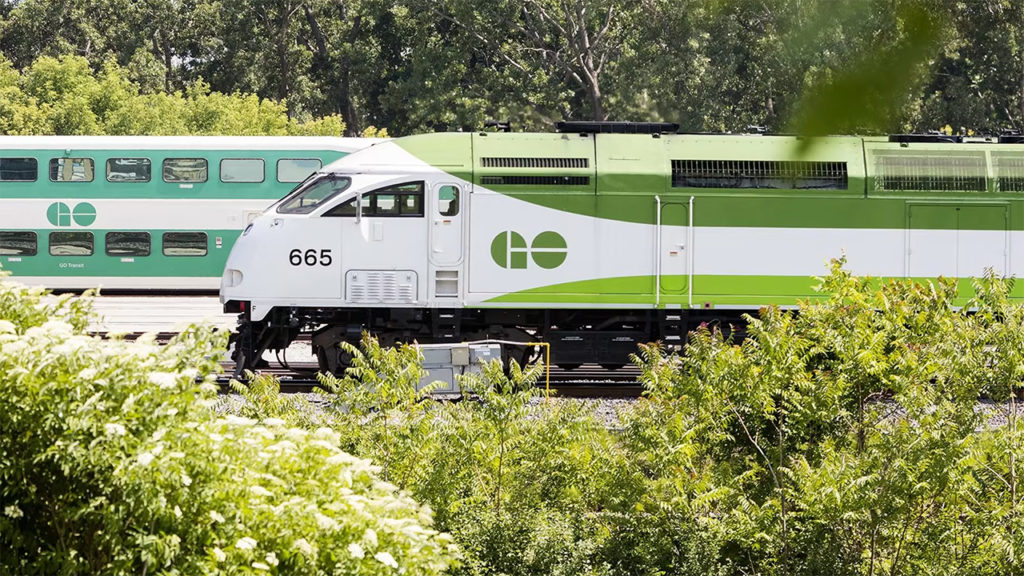
The Ontario government on Aug. 16 reported that it is investing in infrastructure upgrades at the Aurora GO Station to provide commuters with better service, more transit connections and future two-way, all-day service between Aurora GO Station and Union Station in Toronto.
Work will include a new second platform and track, a new pedestrian tunnel with elevators, additional parking spaces and rail signal upgrades. Once complete, the new station will improve rider accessibility and support Ontario’s plans for 15-minute two-way, all-day service on the Barrie Line, better serving communities like Aurora, East Gwillimbury and Newmarket, the government said.
First built in 1853, the station was designated a provincial heritage building in 1971 and a federal heritage railway station in 1990. It’s expected that by 2041, the Aurora GO Station will serve more than 5,000 commuters per day.
The modernization project is part of the broader GO Expansion program on the Barrie Line and is jointly funded by the province of Ontario and the government of Canada.
“The upgrades at Aurora GO Station will help bring more GO service to York Region, providing residents with more connections and better service that meets the demands of the growing population,” Metrolinx President and CEO Phil Verster said. “The new second platform, second track, new pedestrian tunnel and elevators are part of GO Expansion and will enable future service every 15 minutes or better, in both directions, all day, to take customers where they need to go, seven days a week.”
SEPTA
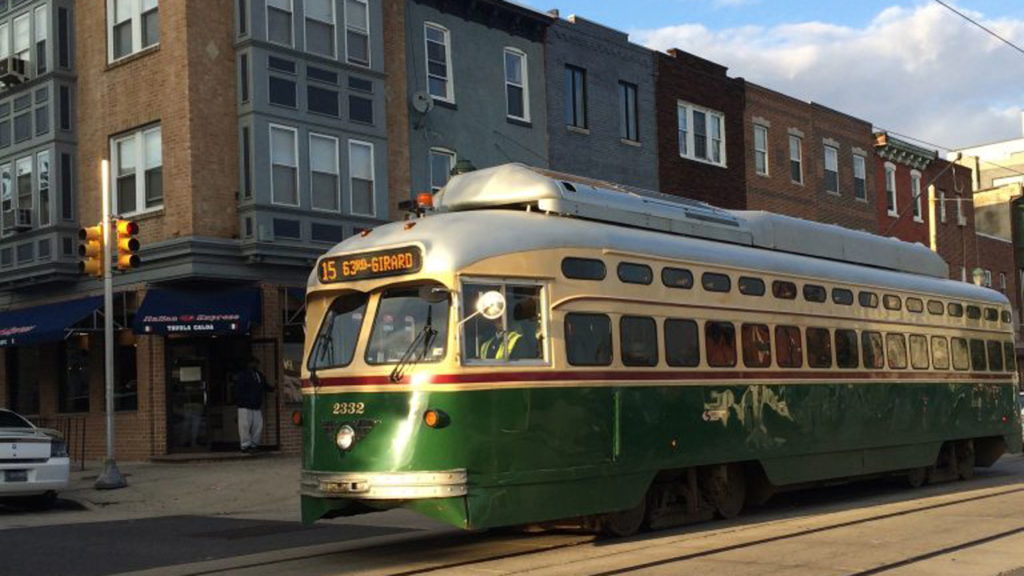
The Philadelphia Inquirer on Aug. 16 reported that six of the 18 PCC cars now being rehabbed will return to SEPTA service Sept. 10. The transit authority told the newspaper that the cars will carry riders on the Route 15 track that runs 8.2 miles along Girard Avenue.
SEPTA has been rebuilding the trolley cars for three years at its Woodland Shop.
“‘When they come in, they are ready for the scrap heap and when they leave here they’re museum-quality almost,’ Brian Aaron, SEPTA’s director of rail vehicle maintenance, said in a recent interview” with the paper.
Each of the six nearly completed PCCs cost approximately $250,000 to restore, and the Inquirer said that SEPTA has been testing them for several months.
According to the newspaper, work on the remaining PCCs, “in various stages of completion, will continue and buses will augment the six redone vehicles on the route until all the trolleys are back in service, SEPTA says.”
The PCCs were taken out of service in the early 1990s, according to the Inquirer, when SEPTA closed several trolley lines due to financial problems. In 2005, 18 returned to service on Route 15 after they were restored at a southwestern Pennsylvania factory, but when they needed restoration again in 2020, SEPTA brought the work in-house.
“But the renaissance is not going to last forever,” according to the Inquirer. “SEPTA’s trolley-modernization plan calls for eventual replacement of the PCC cars by a fleet of new light-rail vehicles that will be fully accessible and operate between fixed stations. It’s not clear when that project might be completed.”
SEPTA has five trolley lines that operate over 40 total miles of track in West Philadelphia and Delaware County and in a tunnel beneath Market Street in Center City.
Trillium Line
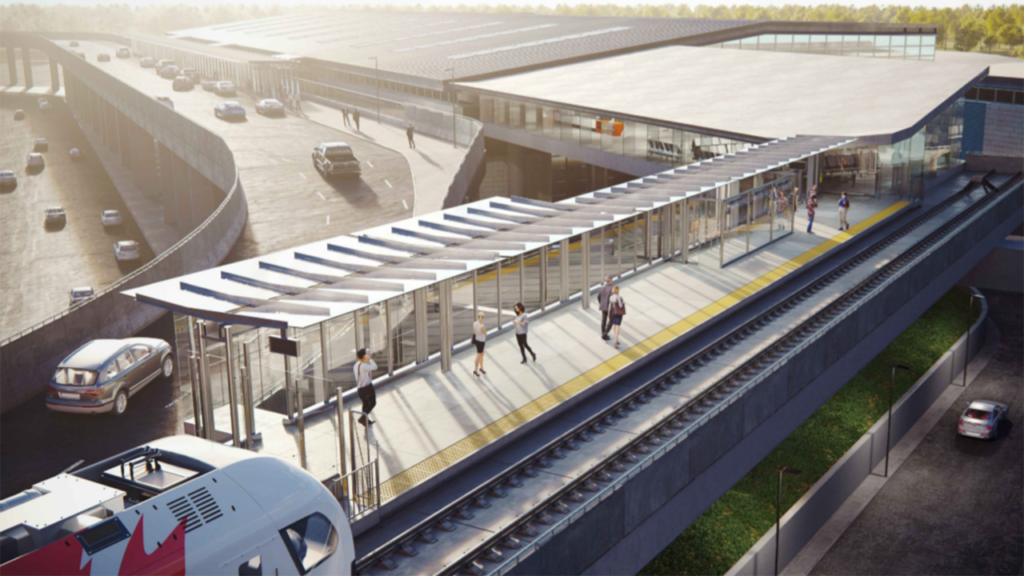
Due to a construction delay, the DMU Trillium Line will not be handed over to the city of Ottawa until at least early November, according to an Aug. 16 report by CTV News.
“Councillors received an update on construction for Stage 2 of the rail system in Ottawa on Wednesday [Aug. 16], including the north-south [Trillium] line from Bayview Station to Riverside South, with a spur to the Ottawa International Airport,” the media outlet reported.
“[T]he updated working timeline for the project handover is before the end of the year,” Ottawa Director of Rail Construction Michael Morgan said, according to CTV News. “‘There remains some risk and uncertainty in the completion’ of the remaining work.
“Trackwork is largely complete; however, progress on signal testing is advancing slowly and requires additional time, which is pushing the overall handover timeline to no sooner than early November.
“Staff also continue to monitor progress at stations noting that all stations still require occupancy permits and all stations require TSSA approvals for elevators.’”
According to CTV News, Morgan, in May, said trial running was planned to begin in September, with handover in the first or second week of October. Handover can only be done upon successful completion of signal testing and system-wide commissioning, including stations; Transport Canada approvals; and training completion, CTV News reported Morgan as saying.
When the construction and testing and commissioning program is finished, TransitNEXT will conduct a three-week trial to “validate that all aspects of the system and maintenance activities perform as expected,” Morgan said, according to CTV News. “The system will then be available for OC Transpo to complete any remaining operational readiness activities before determining a final opening date to the public. The duration of this final process for validation of system readiness is still to be determined.”
In total, 16 kilometers (9.94 miles) of track and eight stations will be added to the Trillium Line. Construction began May 3, 2020, necessitating that the 8-kilometer (4.97-mile) original line be temporarily closed for the duration, with replacement bus service. The line was originally expected to open in August 2022, and then it was delayed until this September.
For background on the project, read: “Ottawa LRT Projects Advancing,” a report by Railway Age Canadian Contributing Editor John Thompson.
TriMet
TriMet’s four-month-long disruption for its A Better Red MAX Extension and Reliability Project is nearing the halfway mark on schedule, the transit agency reported Aug. 16.
Over the past two months, crews have been busy with significant demolition and construction of the MAX system between the Gateway Transit Center and Portland International Airport (PDX). The 126-day disruption, which began June 18, is allowing crews to completely replace the PDX MAX station and install a second track along the alignment, between the new station and Air Cargo Road, according to TriMet.
Since the MAX Red Line opened in 2001, this three-quarters-of-a-mile stretch has been served by one track, supporting both PDX’s inbound and outbound trains. Installation of the second track, TriMet said, also involves upgrading rail crossings, signals, rail crossovers and the overhead contact wires, as well as the poles and power systems that support them. This will complete the Red Line’s double-track between PDX and Mt. Hood MAX stations, which the transit agency said will improve efficiency.
During the project, shuttle buses have been serving MAX stations between PDX and Gateway Transit Center. This phase of Better Red is expected to wrap up this fall, with MAX Red Line trains returning to regular service on Oct. 22.
According to TriMet, the PDX MAX Station was demolished during the first few weeks of the disruption to make room for the new station, designed with two parallel tracks in mind. Construction recently began on the new station, with some of the concrete foundations being formed.
TriMet’s A Better Red MAX Extension and Reliability Project will also extend the MAX Red Line 10 stations west, from Beaverton Transit Center to Fair Complex/Hillsboro Airport. The project has been ongoing since September 2021. Now more than 70% completed, the project is expected to be closed out in the summer of 2024.



